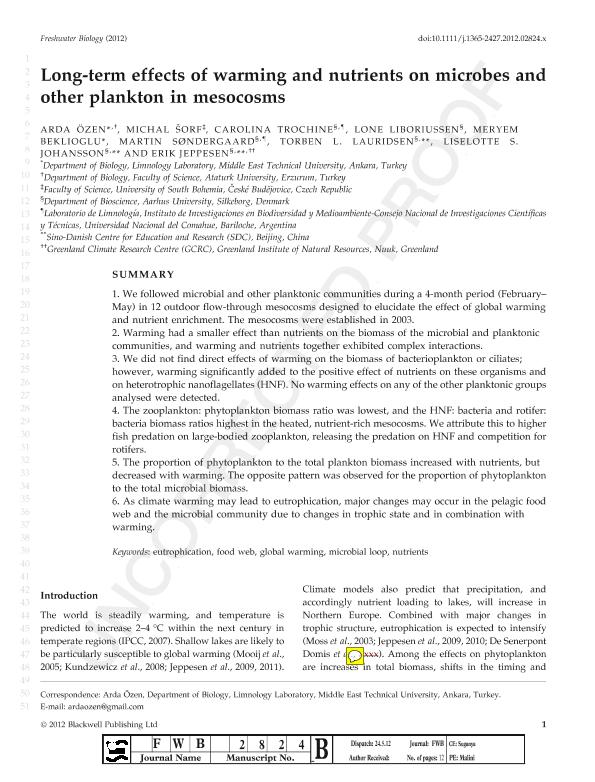Mostrar el registro sencillo del ítem
dc.contributor.author
Özen, Arda
dc.contributor.author
Sorf, Michal
dc.contributor.author
Trochine, Carolina

dc.contributor.author
Liboriussen, Lone
dc.contributor.author
Beklioglu, Meryem
dc.contributor.author
Søndergaard, Martin
dc.contributor.author
Lauridsen, Torben L.
dc.contributor.author
Johansson, Liselotte S.
dc.contributor.author
Jeppesen, Erik
dc.date.available
2016-07-26T19:37:31Z
dc.date.issued
2013-05
dc.identifier.citation
Özen, Arda; Sorf, Michal; Trochine, Carolina; Liboriussen, Lone; Beklioglu, Meryem; et al.; Long-term effects of warming and nutrients on microbes and other plankton in mesocosms; Wiley; Freshwater Biology (print); 58; 3; 5-2013; 483-493
dc.identifier.issn
0046-5070
dc.identifier.uri
http://hdl.handle.net/11336/6701
dc.description.abstract
1. We followed microbial and other planktonic communities during a 4-month period (February–May) in 12 outdoor flow-through mesocosms designed to elucidate the effect of global warming and nutrient enrichment. The mesocosms were established in 2003.
2. Warming had a smaller effect than nutrients on the biomass of the microbial and planktonic communities, and warming and nutrients together exhibited complex interactions.
3. We did not find direct effects of warming on the biomass of bacterioplankton or ciliates; however, warming significantly added to the positive effect of nutrients on these organisms and on heterotrophic nanoflagellates (HNF). No warming effects on any of the other planktonic groups analysed were detected.
4. The zooplankton: phytoplankton biomass ratio was lowest, and the HNF: bacteria and rotifer: bacteria biomass ratios highest in the heated, nutrient-rich mesocosms. We attribute this to higher fish predation on large-bodied zooplankton, releasing the predation on HNF and competition for rotifers.
5. The proportion of phytoplankton to the total plankton biomass increased with nutrients, but decreased with warming. The opposite pattern was observed for the proportion of phytoplankton to the total microbial biomass.
6. As climate warming may lead to eutrophication, major changes may occur in the pelagic food web and the microbial community due to changes in trophic state and in combination with warming.
dc.format
application/pdf
dc.language.iso
eng
dc.publisher
Wiley

dc.rights
info:eu-repo/semantics/openAccess
dc.rights.uri
https://creativecommons.org/licenses/by-nc-sa/2.5/ar/
dc.subject
Eutrophication
dc.subject
Food Web
dc.subject
Global Warming
dc.subject
Microbial Loop-Nutrients
dc.subject.classification
Ecología

dc.subject.classification
Ciencias Biológicas

dc.subject.classification
CIENCIAS NATURALES Y EXACTAS

dc.title
Long-term effects of warming and nutrients on microbes and other plankton in mesocosms
dc.type
info:eu-repo/semantics/article
dc.type
info:ar-repo/semantics/artículo
dc.type
info:eu-repo/semantics/publishedVersion
dc.date.updated
2016-07-22T18:51:55Z
dc.journal.volume
58
dc.journal.number
3
dc.journal.pagination
483-493
dc.journal.pais
Estados Unidos

dc.journal.ciudad
Hoboken
dc.description.fil
Fil: Özen, Arda. Middle East Technical University. Department of Biology. Limnology Laboratory; Turquía. Ataturk University. Faculty of Science. Department of Biology; Turquía
dc.description.fil
Fil: Sorf, Michal. University Of South Bohemia; República Checa
dc.description.fil
Fil: Trochine, Carolina. Aarhus University. Department of Bioscience; Dinamarca. Consejo Nacional de Investigaciones Científicas y Técnicas. Centro Científico Tecnológico Patagonia Norte. Instituto de Investigación en Biodiversidad y Medioambiente; Argentina
dc.description.fil
Fil: Liboriussen, Lone. Aarhus University. Department of Bioscience; Dinamarca
dc.description.fil
Fil: Beklioglu, Meryem. Middle East Technical University. Department of Biology. Limnology Laboratory; Turquía
dc.description.fil
Fil: Søndergaard, Martin. Aarhus University. Department of Bioscience; Dinamarca. Consejo Nacional de Investigaciones Científicas y Técnicas. Centro Científico Tecnológico Patagonia Norte. Instituto de Investigación en Biodiversidad y Medioambiente; Argentina
dc.description.fil
Fil: Lauridsen, Torben L.. Aarhus University. Department of Bioscience; Dinamarca. Sino-Danish Centre for Education and Research; China
dc.description.fil
Fil: Johansson, Liselotte S.. Aarhus University. Department of Bioscience; Dinamarca. Sino-Danish Centre for Education and Research; China
dc.description.fil
Fil: Jeppesen, Erik. Aarhus University. Department of Bioscience; Dinamarca. Sino-Danish Centre for Education and Research; China. Greenland Institute of Natural Resources. Greenland Climate Research Centre; Groenlandia
dc.journal.title
Freshwater Biology (print)

dc.relation.alternativeid
info:eu-repo/semantics/altIdentifier/url/http://onlinelibrary.wiley.com/doi/10.1111/j.1365-2427.2012.02824.x/abstract
dc.relation.alternativeid
info:eu-repo/semantics/altIdentifier/doi/http://dx.doi.org/10.1111/j.1365-2427.2012.02824.x
dc.relation.alternativeid
info:eu-repo/semantics/altIdentifier/doi/10.1111/j.1365-2427.2012.02824.x
Archivos asociados
